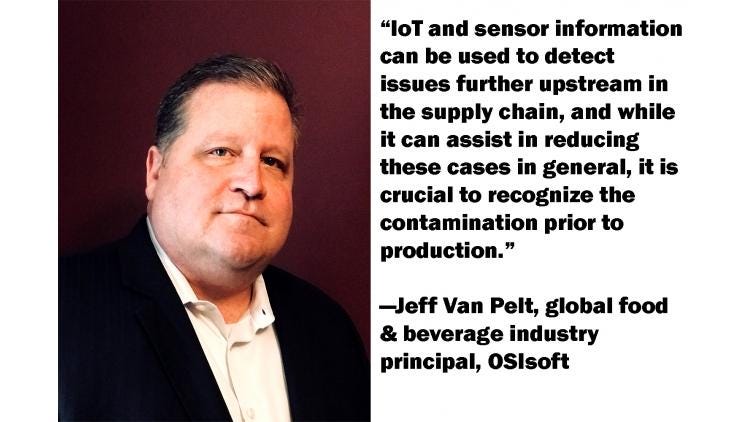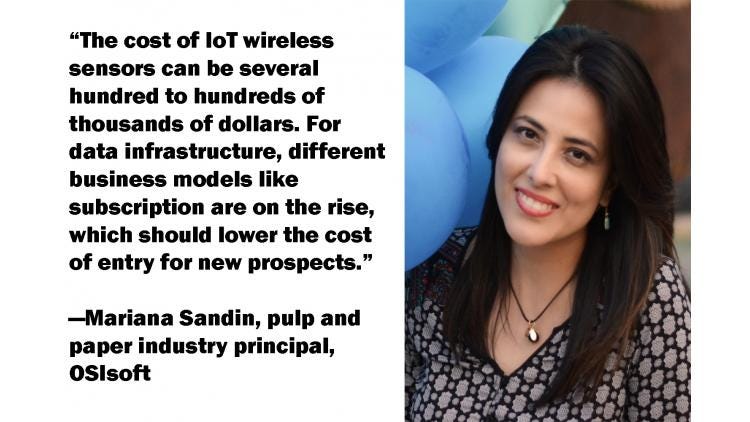September 20, 2018

OSIsoft taps the Internet of Things and a distributed network of sensors to increase fresh and packaged food safety through prevention and responsive recall capability.
Consumers’ relationship with food is changing—they demand transparency about its contents and origin–and is for good reason. The World Health Organization estimates that nearly 1 in 10 people are sickened yearly from eating contaminated food leading to 420,000 deaths.
Given these sobering statistics, manufacturers are under increasing pressure to track and trace food from farm to shelf, quite an undertaking that requires leading-edge technology. For example, blockchain can be used in the cold chain to track food every step of the way.
Major brand owners including Hershey, Kellogg’s, Tyson Foods and Deschutes Brewery are using OSIsoft's technology to not only protect food, but to improve operations and cut costs. Tyson uses OSIsoft sensors and data to track and monitor temperature control of their products to ensure food safety and prevent recalls.
Packaging Digest sought to dig deeper into the intersection of the Internet of Things and food safety, and tapped the expertise of Mariana Sandin, Pulp and Paper Industry Principal for OSIsoft, and Jeff Van Pelt, Global Food & Beverage Industry Principal at OSIsoft.

What’s a high-level view of packaged food recalls?
Van Pelt: Food recalls spiked more 92% in the U.S. from 2012 to 2017 (tracked by the Stericycle Recall Index), in part due to a more complex supply chain and, to some degree, better reporting and tracking. Bacteria, undeclared allergens and foreign substances were the big culprits. A recall can cost $20 million or more, along with, of course, risking the public’s health and damaging a brand. But here’s the good news: they’ve been declining since late 2016 with greater awareness and more action from producers.
What’s not working with the way things have been done traditionally?
Van Pelt: It’s a very complex supply chain. Ingredients are harvested internationally from multiple suppliers, processed into an ever growing selection of foods and then shipped across broad geographic areas. The growth of the industry and the growing demands of customers have really challenged the industry to keep up.
How does a recall work?
Sandin: The FDA determines a mandatory recall of certain products. It is up to the importer to verify that the suppliers comply with new FSMA regulations. Food and packaging manufacturers are responsible for having a system of record and good documentation of the items being shipped. So, going back to packing and the RFID codes, the batch number pointing to the date and place of manufacturing can help to target a recall, instead of recalling all products from all plants during the summer season.
How does IoT technology fit in as an enabler?
Van Pelt: Think of IoT as nervous system for the industrial world. With IoT technologies you can track shipments or trace changes in temperature, moisture or other factors that can have an impact on food quality. Not only can you find problems quicker with this technology, you can narrow the scope of recall
How much of the overall recalls could be addressed with an IoT solution?
Van Pelt: From a production standpoint, IoT solutions can drastically reduce recalls from issues like labeling, processing defects, physical contamination, chemical contamination etc. The main cause for recall in the food and beverage industry is microbiological in nature, with the majority of cases involving fruit and produce. IoT and sensor information can be used to detect issues further upstream in the supply chain, and while it can assist in reducing these cases in general, it is crucial to recognize the contamination prior to production.

What are the key advantages of this high-tech solution?
Van Pelt: Ingredients and completed foods will change hands several times before a consumer buys them. IoT can give you, potentially, a complete picture of a product’s life cycle. You can’t do this with clipboards and periodic inspections.
What infrastructure is needed?
Van Pelt: You need sensors or some sort of measuring device along with a data infrastructure that lets you capture data, share it, and send the necessary alarms. The technology has been around for a while. The key is how it gets implemented.

How much would an IoT implementation cost?
Sandin: The cost of IoT wireless sensors can be few hundred dollars to hundreds of thousands of dollars, depending on the scope. As for the cost of a data infrastructure, it also depends on the scope and the corporation. Different business models like subscription are on the rise, which should lower the cost of entry for new prospects.
What’s needed to make that happen?
Sandin: Today, the packaging industry is doing its share as with technologies radio-frequency identification or Batch ID codes. With supply chains, having data—think of this a horizontal IT layer that lets people share and access machine data—removes the barriers of communication between the food manufacturer and the packing supplier. Some IoT sensors today still have the challenge of battery life, but trailer trucks or other vehicles can definitely monitor the environment those boxes are moved around.
What’s happening with this kind of solution?
Sandin: The PI System has a system of record for their operational data for a number of companies in both food and paper. What is interesting is that both food and paper manufacturers are adopting IoT to help ensure product quality and brand integrity. In some industries, the IoT discussions revolve around cost or energy reduction. By contrast, in food and paper, brand integrity is often the paramount concern.
What else do brands need to know?
Sandin: IoT serves as a tool to remove the collaboration barriers between food manufacturers, regulatory agencies and the final customer that can be retailers or consumers. IoT increases transparency of information and helps to deliver better products throughout the supply chain.
Mariana Sandin’s background is in Chemical Engineering and she has an MBA with a concentration in Economics from the University of St. Thomas in Houston, TX. She has more than 10 years of experience in real-time data solutions, and is passionate about helping the process industries transform their world with the power of data.
Jeff Van Pelt is responsible for industry strategy, segment development, thought leadership and ensuring customers drive value from their technology investments. Van Pelt is a 30-year veteran in the consumer products industry in a variety of roles. Prior to joining OSIsoft, he held industry executive positions at IBM and SAP.
___________________________________________________________________________________
MinnPack 2018 (October 31 – November 1, Minneapolis) is part of the Midwest’s largest advanced design and manufacturing event that brings you the latest in materials, automation, packaging and more. ___________________________________________________________________________________
You May Also Like


